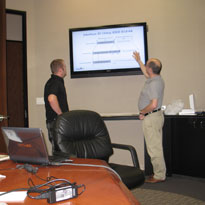Microwave Engineering – Comprehensive
- Course:Microwave Engineering – Comprehensive
- Course ID:MW8-10 Duration:8-10 days Where: Your Office (7+ Persons)
- Download Course Description (PDF)
Available as a private, customized course for your group at your offices or ours and in some cases as a WebLive(TM) class.
Course Outline
- Transmission Networks
- Short haul microwave networks
- Long haul microwave networks
- Transmission Rates Hierarchy
- PCM basics
- PDH network
- SDH network
- ATM basics
- Network Topologies
- Tandem configurations
- Star configurations
- Mesh configurations
- Star-Mesh configurations
- Mixed networks
- Transmission networks for Cellular
- GSM: PCM over Optical; PDH, SDH
- GPRS: IP over Ethernet and Frame Relay
- UMTS: Frames over ATM
- LTE: IP based traffic, the MBPN network
- Brief Introduction to Wireless Radio Communications
- Wireless systems design challenges
- The wireless channel
- Propagation models
- Large scale propagation
- Small scale propagation
- Rayleigh model
- Ricean model
- Nakagami model
- Wireless multipath channels
- Spatial channel models and antennas
- Space-Frequency Diversity
- Modulation Schemes
- AM systems
- FM systems
- Digital Wireless systems
- Line codes
- ASK, FSK, PSK, MSK, QPSK, QAM modulation schemes presentation
- Modulation techniques over fading channels
- Key Radio Fundamentals
- Equalization principles
- Fundamental principles of channel coding
- Error correction & error detection principles
- Introduction to Forward Error Correction Coding (FEC)
- Block coding
- Convolutional coding
- Interleaving
- Diversity principles
- Multiple Access Techniques
- FDMA
- TDMA
- Direct sequence spread spectrum principles
- Automatic Transmission Power Control (ATPC)
- Errorless Vs. Hitless Receiver Switching
- Transmitter Receiver Characteristics
- System Gain
- Dispersive Fade Margin
- Radio Thermal Noise
- Signal to Noise ratio S/N
- Receiver sensitivity
- Modulation and S/N
- Design principles
- Antenna System Considerations; Transmission Lines
- Antenna classifications
- Antenna types
- Standard antennas
- High performance antennas
- Extra high performance antennas
- Transmission lines basics
- Antenna electrical characteristics (Gain, Antenna Lobes, Beam width, Antenna Polarization, VSWR)
- Antenna system accessories (Antenna Dehydrators, Antenna Grounding, Antenna Fields)
- Antenna Installations
- Feeder cables
- Customer library
- Safety regulations
- Mounting connectors
- Sealing connectors
- Antenna spacing and directioning requirements
- Site Installation planning and procedures
- Site Installation documentation
- Earthing and lightning protection
- Roxtec installation
- Antenna system testing
- Practical exercises
- Microwave Propagation
- Microwave propagations in Fading Free conditions
- Fading Mechanisms in MW networks
- Ground reflections
- Radio meteorological parameters
- MW Radio Planning
- Propagation and prediction methods
- Frequency planning and interference calculations
- Far interference planning principles
- Radio spectrum and channel arrangements
- Quality over MW links
- MW Links Design
- Access and Short haul radio parts
- Marconi LH system description
- Case studies
- Tools for Planning
- Planning with ATPC
- TEMS link planner tool
- Planning examples – case studies
- Passive Repeaters – Planning Considerations
- Outdoor
- Indoor
- RF Exposure Principles
- Outline the fundamental characteristics of a radio wave
- Describe the exposure quantities (field strength and power density)
- Understand dosimetric quantity Specific Absorption Rate (SAR)
- Describe the guidelines relating to electromagnetic field exposure
- Outline the major organizations setting RF exposure limits (ICNIRP, IEEE)
- Describe RF exposure assessment methods and standards
- Estimate the RF exposure from an antenna
- Describe how to achieve a safe installation
- Transmission Network Commissioning
- MW Network Management Principles
- Real MW links and Vendor Technology Elements
- Transmission MW Links for Cellular Networks
- Capacity planning considerations
- Case studies
- Wrap-up: Course Recap, Q/A, and Evaluations
Course in a Nutshell
This course is intended to provide the participants with a sound understanding of Radio Transmission Systems Engineering and to allow them to understand major engineering considerations involved when planning and deploying digital microwave radio transmission networks.
At the end of this course, you will understand the essentials of radio systems engineering and radio link planning and will be able to design and manage microwave networks such that the best network topologies are selected and paths are designed for lowest possible operations and maintenance costs. Description of the transmission network of RAN & UTRAN is given as example and basic transmission rate hierarchy is provided as well.
Customize It!
This program can be taught in eight to ten days (8-10 days), depending on the depth desired by the client, and can be divided into two courses of four-to-five days each (a four-to-five day basic course and a four-to-five day advanced course).
Aimed At
Those who wish to undertake a comprehensive program of instruction in the microwaves systems engineering principles and techniques.
Prerequisites
None

